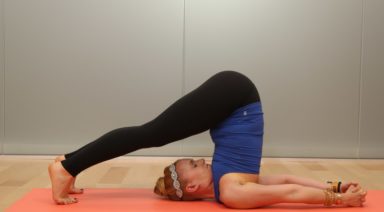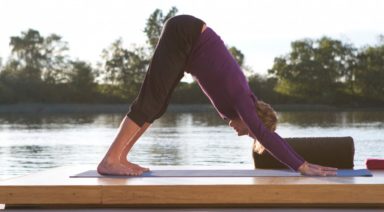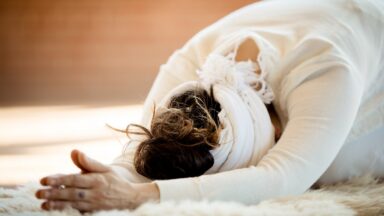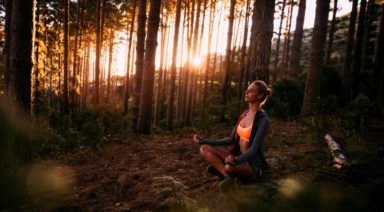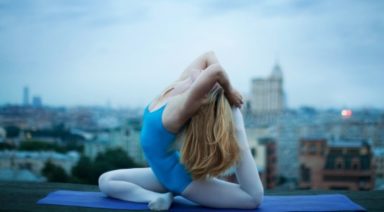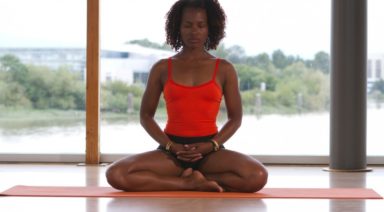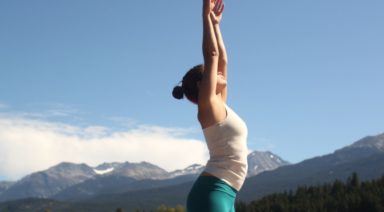3 Ways to Cultivate and Keep a Home Yoga Practice

Starting a home practice can be a daunting task. When I talk to students about starting a home practice, the same topics keep coming up: They don’t have the space or the time, they’ve tried but can’t stick with it or when they try, they don’t end up doing the type of practice they would like to. A home practice can teach you to follow your intuition and how to listen to your body. It will teach you to make time for yourself and it will allow you to reap the benefits daily practice can bring.
Below are my top three tips for starting and keeping, a home practice:
1. Keep a journal, calendar, or both.
Why? It keeps you accountable. By writing on your calendar that you are practicing that night, you’ll motivate yourself to practice so as to avoid staring at your missed commitment the following day. A missed practice can be a big kick in the pants.
I keep my journal on a shelf in my home practice space. When I was working on incorporating consistent practice into my life, having the journal there always got me to go to my practice area, even if I had told myself I didn’t have time, or was too tired to practice. No matter what, I could always convince myself that I had time to jot down what I was feeling in my journal. After a few instances of writing but not practicing, it started to feel ridiculous to be there and not practice. One new habit fed the other.
I have both a calendar and a health journal. I check my practice off on my calendar when I’ve completed it, and I write in the journal even if I don’t do a practice. Both keep me accountable and motivated.
2. Release your expectations. All of them.
Don’t worry about having the “perfect” space to practice. Don’t worry about how much time you were able to spend on your practice on any given day, and definitely don’t worry about the kind of practice you decide to do. Find a spot that’s big enough to roll out your mat and start there. If it helps, you can set up a special space where you can keep your yoga stuff. Try setting up an alter, but don’t let an imagined need for such a space keep you from starting your practice today. All you need is one space that is big enough to lay out a yoga mat. Period.
One of the issues I faced when I was starting my home practice was making the time. It seemed like a rare occasion when I had enough time to do what I would consider to be a practice; however, once I got serious about starting a home practice, this was one of the first beliefs that I had to let go off. Some nights I come to the mat exhausted and my practice is savasana, and only savasana. Whether you practice one pose or fifty, it doesn’t matter. I don’t judge and I don’t talk down to myself as though it wasn’t enough. I don’t wish I’d done “more.” I come to the mat with the time I have and I do what works for me on that day.
This goes for the type of practice too. When I started my home practice, I had this idea in my head that my mornings would be set aside for restorative and that I would rock a vinyasa flow in the evenings. I soon learned that I had to let go of what I thought I should be doing and just do what my body told me to do. If that meant doing restorative, I did restorative. If I felt energized, I did a flow. The same rules as above apply.
Don’t judge it, and don’t think it doesn’t count just because it didn’t meet an expectation you had set out for yourself. If you do, you’ll risk getting caught up in the downward spiral of feeling like you aren’t “really” doing a home practice, and once you’re there, it’s very easy to continue with those thoughts and eventually decide that your excuses and downfalls are more powerful than your wish to practice at home. This is where a lot of us end up. Don’t give up on yourself. Persevere through these thoughts.
3. Treat yourself with compassion.
The last tip is probably the most important one. It ties into releasing your expectations and it also helps you to honor your intuition. This is one of the best gifts that a home practice has to give. So, instead of beating yourself up for not doing a practice the day before, forgive yourself, let it go, and roll out your yoga mat. Instead of thinking that you really wanted to do a more physical practice and the yin practice you just did wasn’t enough, respect yourself for listening to your body’s needs and meeting them. Roll out that mat again and again without expectation. Be gentle with your thoughts. When you greet yourself with positivity instead of negativity a whole new world opens up to you, both on and off the mat.
Broga: 6 Things Every Man New To Yoga Must Know

If you’re a man thinking of taking up yoga, or you’ve just started, then you must read this. It will save you time, confusion and even a bit of embarrassment.
Eyes Wide Shut Guys, when in down dog, learn to close your eyes and get into the pose. Why? One, to feel your way into a deeper stretch. Two, and perhaps more importantly, if you’re in front of a woman and she’s moving through her vinyasa, you could be making it awkward. You may want to be staring at your belly button, but trust me, those eyes may wander and make someone feel uncomfortable.
Kiss My Asana. When you’re in prasarita (a wide-legged forward bend) and you’re in a full class, please be considerate. Stagger your position with your neighbors, and as recommended in the point above, close your eyes. You also want to make sure you’re giving your female neighbors plenty of space coming in and out of the pose, just in case it looks like you’re trying to be a little too… neighborly.




